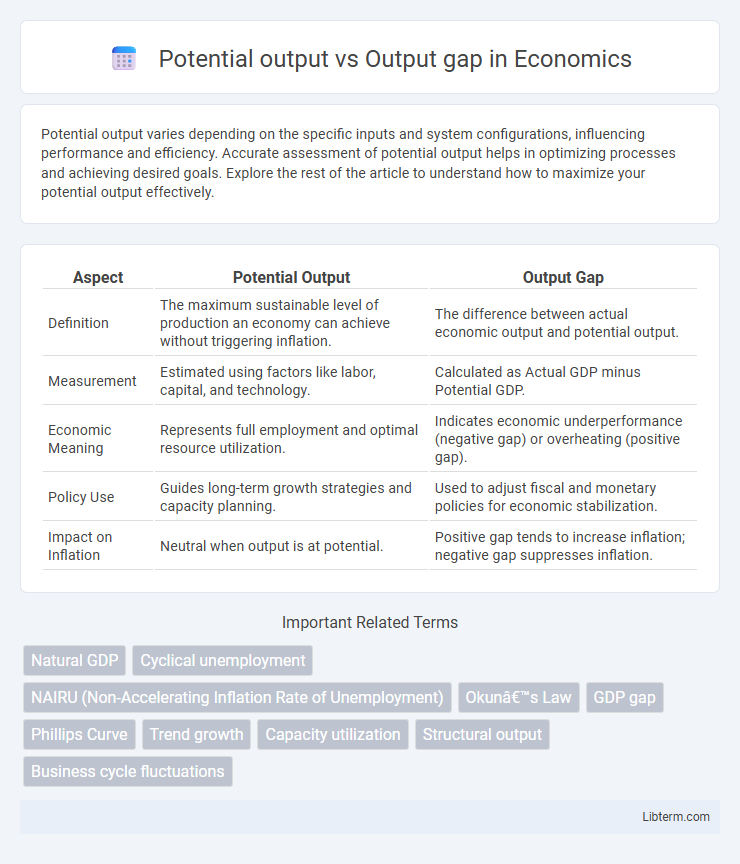Potential output varies depending on the specific inputs and system configurations, influencing performance and efficiency. Accurate assessment of potential output helps in optimizing processes and achieving desired goals. Explore the rest of the article to understand how to maximize your potential output effectively.
Table of Comparison
| Aspect | Potential Output | Output Gap |
|---|---|---|
| Definition | The maximum sustainable level of production an economy can achieve without triggering inflation. | The difference between actual economic output and potential output. |
| Measurement | Estimated using factors like labor, capital, and technology. | Calculated as Actual GDP minus Potential GDP. |
| Economic Meaning | Represents full employment and optimal resource utilization. | Indicates economic underperformance (negative gap) or overheating (positive gap). |
| Policy Use | Guides long-term growth strategies and capacity planning. | Used to adjust fiscal and monetary policies for economic stabilization. |
| Impact on Inflation | Neutral when output is at potential. | Positive gap tends to increase inflation; negative gap suppresses inflation. |
Understanding Potential Output
Potential output represents the maximum sustainable level of production an economy can achieve without triggering inflation, reflecting full utilization of labor, capital, and technology. Understanding potential output is crucial for assessing economic health, as it sets a benchmark to measure actual output and identify output gaps. The output gap, defined as the difference between actual output and potential output, signals underutilized resources or overheating economy conditions.
Defining the Output Gap
The output gap measures the difference between an economy's actual output and its potential output, which represents the maximum sustainable level of production without triggering inflation. A positive output gap indicates the economy is producing above its potential, often leading to inflationary pressures, while a negative output gap signals underutilized resources and economic slack. Defining the output gap is crucial for policymakers to adjust fiscal and monetary strategies aimed at stabilizing economic growth and controlling inflation.
Measuring Potential Output: Methods and Challenges
Measuring potential output involves estimating the maximum sustainable level of production an economy can achieve without triggering inflation, using methods such as the production function approach, statistical filters like the Hodrick-Prescott filter, and structural econometric models. Challenges include data limitations, model specification errors, and the dynamic nature of economic factors affecting productivity and labor utilization. Accurate measurement is critical for assessing the output gap, which reflects deviations of actual output from potential output and guides monetary and fiscal policy decisions.
Types of Output Gaps: Positive vs Negative
A positive output gap occurs when actual economic output exceeds potential output, indicating an economy operating above its sustainable capacity, often causing inflationary pressures due to excess demand. A negative output gap exists when actual output falls short of potential output, reflecting underused resources and labor, leading to unemployment and reduced economic growth. Understanding these gaps helps policymakers adjust fiscal and monetary strategies to stabilize inflation and promote full employment.
Economic Implications of Output Gaps
Output gap measures the difference between actual GDP and potential output, indicating underutilized or overheated economic capacity. A positive output gap suggests inflationary pressure due to demand exceeding supply, while a negative gap reflects unemployment and idle resources. Policymakers use output gaps to adjust fiscal and monetary policies aimed at stabilizing inflation and promoting sustainable growth.
Factors Influencing Potential Output
Potential output represents the maximum sustainable level of GDP an economy can produce without triggering inflation, influenced by factors such as labor force growth, technological advancements, and capital stock accumulation. Changes in education quality, workforce skills, and innovation directly impact productivity, shifting the economy's long-term productive capacity. Variations in institutional efficiency, infrastructure development, and demographic trends also play crucial roles in determining the potential output level.
Output Gap and Inflation Dynamics
The output gap measures the deviation of actual economic output from potential output, serving as a critical indicator of economic slack or overheating. A positive output gap, where actual output exceeds potential output, typically leads to upward pressure on inflation due to increased demand and resource constraints. Conversely, a negative output gap signals underutilized capacity, often resulting in subdued inflation and downward pressure on prices.
Policy Responses to Output Gaps
Policy responses to output gaps focus on stimulating economic activity when actual output falls below potential output, often through expansionary fiscal policies such as increased government spending or tax cuts to boost aggregate demand. Central banks may implement accommodative monetary policies by lowering interest rates to encourage borrowing and investment, helping to close negative output gaps. Conversely, when output exceeds potential, contractionary policies aim to prevent overheating and inflation by tightening fiscal and monetary measures.
Output Gap in Historical Economic Crises
The output gap measures the difference between actual economic output and potential output, revealing economic inefficiencies during historical crises such as the Great Depression and the 2008 financial crisis. A negative output gap indicates underutilized resources and high unemployment, often linked to recessions and prolonged economic downturns. Policymakers use output gap analysis to implement fiscal or monetary stimulus aimed at restoring economic equilibrium and stimulating growth during these critical periods.
Future Trends and Research on Output Gap Analysis
Emerging research on output gap analysis emphasizes integrating real-time data and advanced machine learning algorithms to enhance the accuracy of identifying deviations between actual output and potential output. Future trends suggest leveraging high-frequency economic indicators and structural models to better capture dynamic changes in productivity and labor markets. This approach aims to refine monetary policy decisions by providing more precise estimates of the output gap under varying economic conditions.
Potential output Infographic

 libterm.com
libterm.com